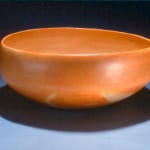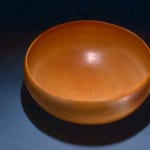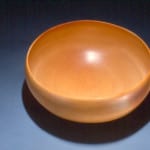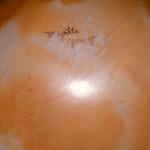Hopi plainware Piki bowl by Myrtle Luke Young, “middle village,” First Mesa. Myrtle Young made exceptionally thin, evenly formed and graceful pottery. Given its large size and purpose, this bowl was probably made for use in a Hopi home rather than for sale to tourists.
The Autumn 2007 issue of American Indian Art Magazine (Vol. 32, #4) contains an article by Karen Charley and Lea McChesney, “Indigenous Aesthetics: a Hopi Pottery Perspective. They write:
“The pot’s blush evinces the presence of a heart, both the heart of the object that emerges from the fire and the larger effort required to make it…as evidenced by their blush…pots contain the emotional sustenance necessary to carry Hopi blessings into the world (2007:89-90). Hopi pots have heart; they also have voice: Charley and McChesney note that
“…unless [a] pot rings clear when struck lightly but firmly with the flick of a finger, it is not whole. The most highly valued vessels resonate with a bell-like sound (2007:86).”
The extensive blushing of 1993-05 and the ghost image of the shards used to protect the pot during firing give this pot great heart. Its exceptional size, uniform thinness, and good firing give it a clear tonal voice when lightly struck. Art, including Hopi art, can be made with the conscious intent to startle and impress. Very different is the spirit of 1993-05. Perhaps because it is plainware, perhaps because it was made to be used to bring the blessings of corn to the Hopi people, certainly because the bowl is full of the grace, beauty and voice of its maker, this piki bowl is a gentle Hopi-Tewa blessing. The collection contains no better example of the essence of Hopi/Hopi-Tewa life, values, and spirit.
The Museum of Northern Arizona has three Myrtle Luther Young piki bowls in its collection: #E453 made in 1938, #E556 made in 1939 and #E6311 made 34 years later In 1973 (Allen,1984). A long and productive career! The July 1936 MNA article (Bartlett, 1936:96) recognizes “Myrtle Luke” as among the seven “fine potters” from Hano. I assume we are talking about the same person. For a Myrtle Young piki bowl similar to 1993-05, see Southwestern Association on Indian Affairs (1991:32). A second similar Myrtle Young piki bowl made in 1970 is illustrated in Barry (1984:84, #147). As part of an effort to document southwestern art, the Heard Museum has made a video of Mark Tahbo discussing the making and form of a Myrtle Young piki bowl that appears to be identical to 1993-05.
According to Bruce McGee, he began buying Piki bowls from Myrtle Young about 1968 and reselling them at his Keam’s Canyon Trading Post. He purchased these bowls at the request of Hopi women who could then buy the bowls from him cheaper and more conveniently than directly from the potter. In the late 1960s Myrtle Young piki bowls sold for about $30 to $40, according to McGee. Myrtle Young, the sister of Garnet Pavetea, was born in 1904 and died in 1984. According to her daughter Enid Young (May ‘94) her mother had a stroke in the late 1970s. Her family home in Shomopovi has been restored using traditional Hopi methods. Enid (Box 755 Polacca 86042) asked that I send her a picture of 1993-05.
I found 1993-05 by chance. I was invited by Margaret Kilgore to visit her ranch at Blue, Arizona, about six hours by car west of Scottsdale. On May 14, while driving to the ranch, I stopped at Carlyon’s Gift Shop in Payson for a break. From the outside the shop looked silly and fun but offered no promise of great pottery [see pictures of Bill Carlyon and the shop on file]. On the lower shelf of a case and filled with bric-a-brac was this Myrtle Young bowl. Carlyon purchased a variety of fossils and ethnographic material from the widow of an archeologist in 1965. This bowl was among the items he bought. Although obviously made before 1965, the date of this pot seems impossible to determine. Since this pot is signed and signing pots did not become common until the 1950s or 1960s, Young probably made this bowl when she was an older woman.
For an older piki bowl that was basket-formed, see 2010-17







